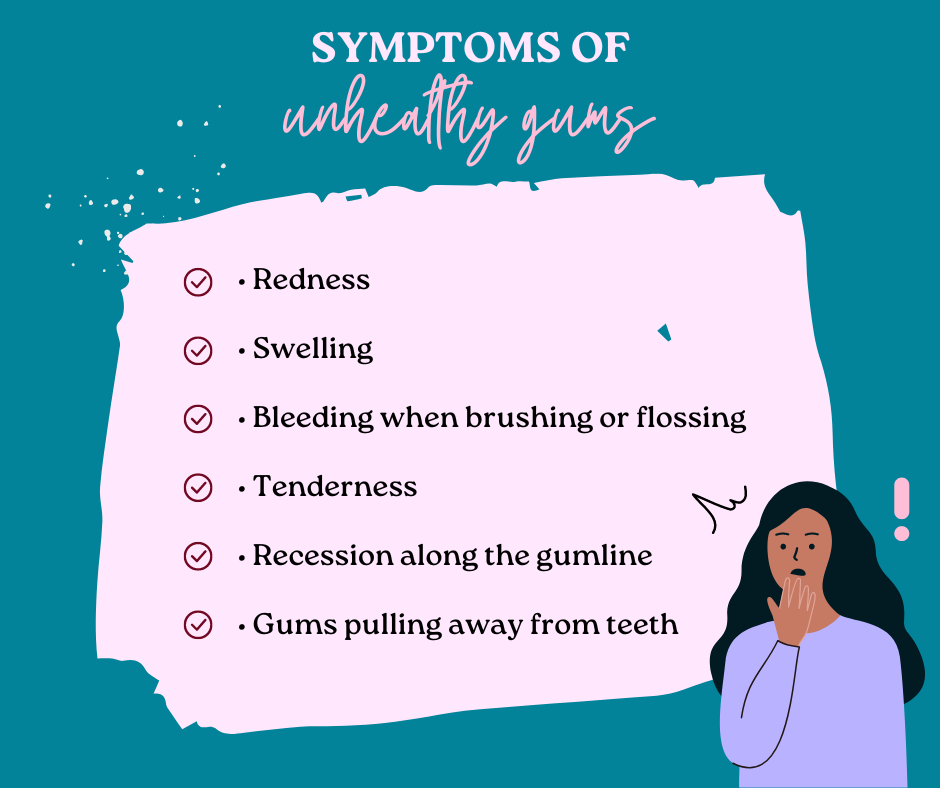September is here, which means welcoming the beginning of autumn, cooler weather, and most importantly in dentistry, National Gum Care Month! You probably already know the importance of good oral health, but you may not know how to give your gums the best care or how to identify the signs and symptoms of gum disease.
Know Your Gum Diseases
There are two types of gum disease: gingivitis and periodontitis. Gingivitis occurs when plaque builds up and causes gum inflammation and bleeding. Of the two types of gum disease, gingivitis is less severe, and gum disease will start here and progress into periodontitis if left untreated. At the gingivitis stage, it is simple enough to treat and reverse the damage, which is why it is important to keep up with your regular dental cleaning appointments so that your dentist can catch it early.
Periodontitis, the secondary stage of gum disease, happens when tartar accumulates around the gumline and causes the formation of pockets around the teeth. These gum pockets allow bacteria and plaque to spread, destroying the tissues that keep your teeth secure in your mouth. With advanced periodontitis, you can lose your teeth. It’s the number one cause of adult tooth loss, so stopping gum disease in its tracks before it gets to this point is essential!
According to the CDC, gum diseases are more likely to affect certain demographics. The most at-risk groups are men, senior adults, and people living below the federal poverty line or who did not graduate from high school. Women experiencing hormonal changes such as pregnancy—or even simply using the birth control pill—have increased risk as well. Finally, genetics can also play a role. If your family is prone to dental problems, chances are you will be too.
 Graphic of surprised woman and list of symptoms of unhealthy gums that is pulled from article
Graphic of surprised woman and list of symptoms of unhealthy gums that is pulled from article
Healthy or Unhealthy?
Look in the mirror—are your gums healthy? Healthy gums should be pink, firm, and not have any bleeding or swelling when you floss or brush your teeth. Unhealthy gums are likely to have some or all of these symptoms:
- Redness
- Swelling
- Bleeding when brushing or flossing
- Tenderness
- Recession along the gumline
- Gums pulling away from teeth
If you notice any of these worrying signs, make an appointment with your dentist right away.
Preventing Periodontal Woes
By now, you probably know the drill (pun intended) if you’ve been listening to your dentist, but it bears repeating: brushing, flossing, and regular dental visits are the most important habits you can have to maintain good oral hygiene! These are especially important if you have a family history of poor dental health.
Curbing some of your bad habits can help prevent gum disease. Smoking or not getting enough nutrients in your diet contribute to gum disease and dental deterioration. Brushing your teeth too aggressively or with a toothbrush with firm bristles can damage gums and cause the appearance of gingivitis. Also, be sure to replace your toothbrush or electric toothbrush head once every three months so bristles don’t become too worn to scrub off plaque and massage your gums.
Mouthwashes are an optional step, but these can be a good idea if you are genetically prone to gum disease or have higher-risk habits that you are unwilling or unable to give up. They can reduce the plaque that contributes to gum disease and provide bonuses like whitening teeth and/or freshening breath. There are also mouth rinses that help with dry mouth, and dry mouth can also be a factor in gum disease.
Knowledge is power! Now that you are armed with information, you can create healthy habits that last well beyond September and into the rest of your life.